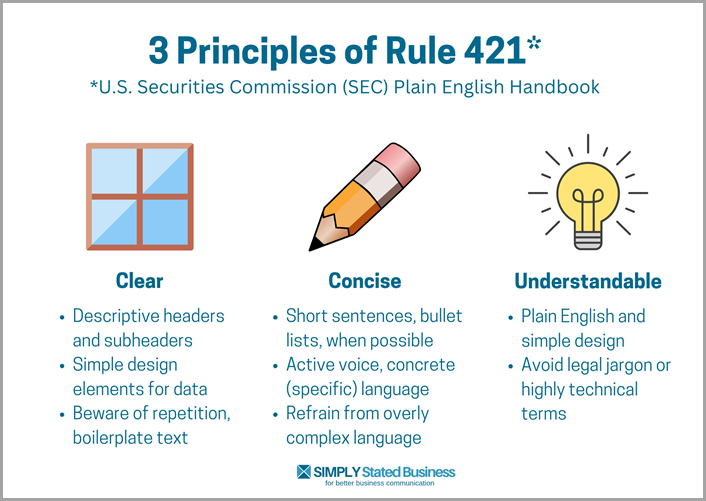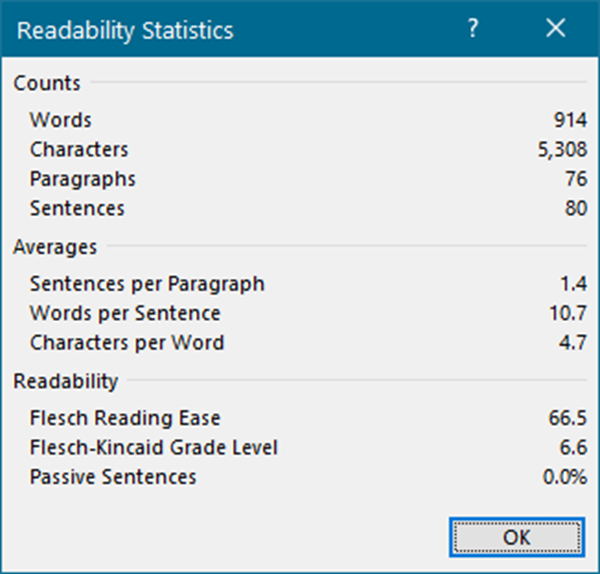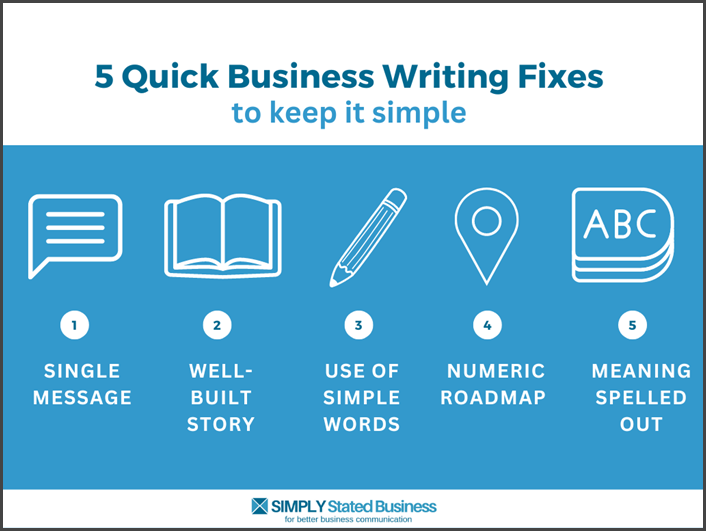 Of all the business writing fixes for better results, one stands out. Keep it simple.
Of all the business writing fixes for better results, one stands out. Keep it simple.
Yet, that fix seems elusive. But what if keeping it simple proved financially favorable?
That’s one fix we could all get behind.
The following shares how simple writing can bring a monetary windfall and offers 5 quick fixes for simpler business communication.
Cashing in on Simple Business Writing
I love when I come across dollars and cents proof of the benefits of keeping it simple. Few results motivate better than money to your bottom line.
Harvard Business Review (HBR) published interesting results in its article, Research: Simple Writing Pays Off (Literally). HBR highlights “a series of studies on the financial value of good writing…”
When you think simple writing, I bet the U.S. Securities and Exchange Commission (SEC) does not jump to the top of your list. Yet, way back in 1998, the SEC published A Plain English Handbook under Chairman Arthur Leavitt.
Rule 421 (of course, they HAD to have rules), 😊 sums up the principles of the guide (as illustrated below).

The article provided additional studies all pointing to a similar conclusion – simple writing saves.
So, let’s get to those 5 quick business writing fixes.
Quick Business Writing Fix #1 – Edit for a single message.
Have you ever walked into a room where everyone was trying to talk over everyone else? It’s like watching an episode of The View.
Business writing becomes a muddled drowning of words when you lack a clear message. Or you have too many messages.
Before you begin to write, stop and think about the point you want to make. Write down the single most important message you want your readers to hear.
For example –
- Message for this post – Keep your business writing simple.
- Message for a sale communication – Get early access to XYZ’s annual sale.
Use that message for building your business communication. It’s your litmus test for editing.
- After writing, ask yourself – does this send a clear message?
- If you have multiple messages, cut back to one.
- Consider separate communication for additional messages.
A single message leaps over a muddled mess of words.
Fix #2 – Repair the holes in your story.
Tell a story is a recommended technique for a more interesting read. But not all of us are the next J. K. Rowling.
Poor storytelling produces poor business writing. So, look for the holes in your story.
- Does the beginning grab your reader?
- Is the middle engaging readers so they keep reading?
- Does the end leave the reader wanting more?
If storytelling does not come naturally, it’s a good idea to have someone else review your story. Or share one of their own.
Warby Parker is an online retailer of prescription glasses, sunglasses, and contacts. Its story is a great example of the power of storytelling done right. Below is an excerpt from its History page.

The story is interesting and something we can relate to (at least those of us in need of vision correction).
Plug holes in your story by grabbing the reader’s attention, keeping it, and leaving them wanting more.
Fix #3 – Flesch out the simple word.
Imagine you are helping your child develop language skills. To help them learn correct pronunciation or use, you don’t use “baby talk.” But you do use simple language.
Try a similar approach with business writing.
Overly complex business communication does not make the writer look smarter. But it could make them boring. Even technical writing benefits from simple language (as established in the HBR article).
While not perfect, the Flesch Reading Ease and Flesch-Kincaid Grade Level tools provide a snapshot for readability. The tests base scores on the number of words, syllables, and sentences.
- The higher the score, the easier your writing is to read.
- The Flesch-Kincaid Grade is based on U.S. grade levels so shoot for lower scores.
- Most word processing software (like Microsoft Word) include these tools.

Replace more complex words with a simpler form. The following are a few examples. You can also download Simple Alternatives to Complex Words.
- Start vs. commence
- Give vs. disseminate
- Help vs. facilitate
- Limits vs. parameters
- Next vs. subsequent
Fix #4 – Use Numerals in Number Lists.
Sounds like double talk, doesn’t it? Let me explain.
You read a line or heading that say, Here are five ways to do this.
- That’s followed by bullet points
- Or plain text
- But no numbers
Admit it. Do you find yourself counting the points to make sure there’s five? If you’re not that nitpicky, I bet you do notice if there’s NOT five points.
Another number tip is from one of my favorite writers, Henneke Duistermaat of Enchanting Marketing. Warning: Writing traditionalists may cringe over the tip.
- Use numbers instead of spelling out the word (and not just in headlines).
- Using the above example – Here are 5 ways to do this.
- The number draws the eye and readers perceive numbers as credible.
Numerals offer readers a simple roadmap for understanding key points.
Fix #5 – Spell it out.
Although a good story is a great technique, you don’t want to keep your readers guessing.
- Spell out acronyms the first time you use them.
- Briefly explain the meaning of technical terms.
- Identify how readers can contact you.
Keep it Simple
There you have it – five quick fixes for your business writing.

What business writing tips do you have? Share them in Comments.
=====================
==================================
Note: This post originally published on March 5, 2012. This November 2, 2022 version updates it.
===================================

Great advice here Cathy, and the same topic I’m focusing on this week.
I especially like using shorter, more common words instead of longer words that few people use. Since I write for the higher education market, I occasionally have to read academic writing, which is notorious for using big words and stilted language.
Hi John: We often seem to be on the same cosmic wavelength. 🙂
I know what you mean about academic writing. Check out insurance and health care writing if you want big words and stilted language. 😀
I’ll be checking out your post. Thanks for stopping by, John.
Great post Cathy! I will help keep these simple fixes in mind when writing my blog posts.
Excellent – and I’ve got one reader who regularly counts my bullet points and lets me know when I’ve miscounted. I get sort of a kick out of it.
Love what you did with Flesch – stopped me cold for a moment.
Marie- I’m glad you found them helpful. 🙂
Anne-LOL! 😀 I would say keep with the bullets – hey, you have to get your fun somewhere. 😉 Thanks, Anne.
Another good one, Cathy. Like Anne, the Flesch thing gave me pause for a second.
Thanks, Sharon. Thought I did another typo, eh? 🙂